Best Battery For Fish Finder In 2023 Reviewed
UPDATED 13 MAY 2023
by Robert Ceran
This article may contain affiliate links. If you make a purchase after clicking on a link we may earn a small commission at no extra cost to you.
Are you looking for a new fish finder battery, but not sure which model is right for you?
For this article my team and I tested the most popular fish finder batteries on the market, and evaluated them on their run time, reliability, durability, and pricing.
Based on our testing, here is our pick of the best fish finder batteries in 2023:
- Best overall: ExpertPower 12V 10AH Lithium
- Best budget: ExpertPower EXP1270 12V 7AH
- Best budget lithium: Dakota Lithium 12V 7AH
- Most durable: Chrome Battery SLA 12V 7AH
- Best 35AH option: Universal Power Group 12V 35 AH

Best fish finder batteries in 2023 reviewed
The table compares the key specs of the top 8 models that we tested side by side.
Now let’s dive into the details and look at each of the models in more detail.
1. ExpertPower 12V 10Ah Lithium LiFePO4 Deep Cycle Rechargeable Battery

Our verdict: best overall battery.

The Expert Power Lithium 12V 10AH is currently one of the best, if not the best lithium fish finder battery on the market.
This battery is based on Lithium Iron Phosphate (LiFePO4) technology, and its biggest advantage is that its charge lasts more than twice as long as a standard SLA (lead acid) battery.
That means you don’t need to worry about running low during your fishing trip, even if you’re on the water all day long.
Based on our testing, it can actually last for 2-3 kayak fishing trips before it needs to be recharged, though most anglers prefer to recharge it after every fishing trip.
In addition, theExpertPower Lithium is almost 70% lighter than SLA batteries of equivalent size, and lasts for 2500 -7000 recharging cycles, whereas SLA batteries only last for 400 recharging cycles on average, which means its lifespan is 6 – 17 times longer.
So, even though the cost of this battery is a little higher than that of SLA batteries, our test results show that the value you get is clearly a lot higher with the ExpertPower 12V 10AH Lithium.

If you purchase the ExpertPower Lithium 12V 10AH battery, remember to use a lithium battery charger to recharge it. We recommend the BikeMaster Lithium Battery Charger.
2. Dakota Lithium 12V 10AH Battery
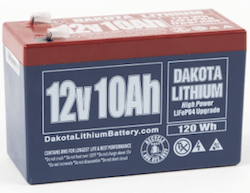
Our verdict: best runner up lithium battery.

The Dakota Lithium 12V 10AH battery is another excellent lithium fish finder battery on the market, and like the ExpertPower battery it is based on Lithium Iron Phosphate (LiFePO4) technology.
The Dakota Lithium is 50% lighter than SLA batteries on average, and lasts for a miniumum of 2000 recharging cycles, whereas SLA batteries only last for 400 recharging cycles on average, which means its lifespan is 4.5X longer than that of an SLA battery.
If you purchase the Dakota Lithium 12V 10AH battery, remember to use a lithium battery charger to recharge it.
We recommend the BikeMaster Lithium Battery Charger.
3. Dakota Lithium 12V 7AH Battery
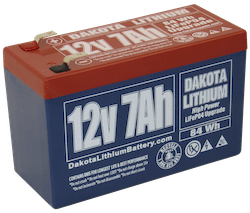
Our verdict: best budget lithium battery.

The Dakota Lithium 12V 7AH battery is very similar in all aspects to the Dakota 12V 10AH, but with 7AH it has a 30% lower amp hour capacity, and also costs 30% less.
During our testing we found that if your fishing trips only tend to be 2-5 hours on average, this battery provides plenty of power capacity for your purposes.
If you purchase the Dakota Lithium 12V 7AH battery, remember to use a lithium battery charger to recharge it. We recommend the BikeMaster Lithium Battery Charger.
4. ExpertPower EXP1270 12V 7AH Lead Acid Rechargeable SLA Battery

Our verdict: best SLA battery.

The ExpertPower EXP1270 is a high quality 12-volt SLA battery. Traditionally used in home security systems, it has been successfully adapted for use as a battery for fish finder and to power other marine electronics.
The EXP1270’s covering is manufactured with hardened ABS plastic to safeguard it from damage and leaks. In addition, the ABS plastic coverings contain glass mat separators and lead plates, which further increase durability.
Overall, our testing revealed that this design makes it highly resistant to the regular punishment it’s likely to experience during kayak fishing, including exposure to saltwater.
In addition, when we put it to the test, we found that it also has a very fast charging time with 4 hours, which means you can still charge it on the day of your fishing trip, in case you forgot to do it the day before.
Since this is an SLA battery, remember to charge it with an SLA battery charger. We recommend using the Peleus Tech 12V portable lead acid battery charger.
5. Chrome Battery SLA 12V 7AH Lead Acid Battery

Our verdict: most durable SLA battery.

This is a very popular lead acid battery that is used for a variety of applications, ranging from residential alarm systems to mobile scooters, and which also works great for powering fish finders.
The Chrome Battery 12V 7AH is a premium quality SLA battery made with lead calcium alloy, and includes both T1 terminals and AGM technology. The result is a totally maintenance-free battery that’s easy to use and performs at a high level.
The battery case is made with welding technology, which protects the lead acid battery from heat, shock, and other common punishments. Its fiberglass mat separators further enhance durability.
Combined, our testing revealed that these features protect the battery from a long list of environmental hazards and other abuse, making it one of the most durable SLA batteries on the market.
Finally, the Chrome Battery 12V 7AH SLA battery is also maintenance-free, meaning you won’t have to worry about water refilling.
Since this is an SLA battery, remember to charge it with an SLA battery charger. We recommend using the Peleus Tech 12V portable lead acid battery charger.
6. Mighty Max YTX20-BS 12V 18AH 270 CCA SLA Power Sport Battery
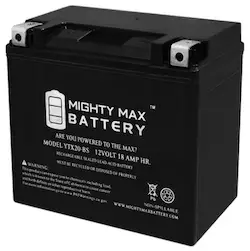
Our verdict: least reliable SLA battery

The Mighty Max YTX20-BS battery utilizes a highly durable, cutting-edge calcium-alloy grid, which gives you outstanding service life and performance.
Highly resistant AGM technology further helps to protect the battery from shock or leakage concerns. The battery is portable, maintenance-free, and easy to use.
This is another popular SLA battery that can be used for all sorts of applications. It is fish finder-mountable and with a high amp hour count of 18AH should remain powered for the length of your fishing expedition. It doesn’t require any refilling or maintenance.
However, be mindful that some users report that the performance of this battery tends to deteriorate rapidly with use, and it requires regular cleaning out of the connecting cables after use, as well as by immediately recharging the unit after each use, to avoid poor performance on the next trip.
Since this is an SLA battery, remember to charge it with an SLA battery charger. We recommend using the Peleus Tech 12V portable lead acid battery charger.
7. Power Sonic 12V 7AH 570 Portable Fish Finder Battery
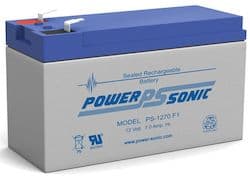
Our verdict: solid & reliable SLA battery

The Power Sonic PS-1270 F1 battery features AGM technology to enhance its functionality.
The 12-volt 7AH battery can be safely used in all sorts of applications, and it is widely used for kayak fish finders. It has optimal compatibility and portability courtesy of the regulated valve. Best of all, the battery is built to be spill-proof.
This is a solid battery, and because it’s totally maintenance-free, it is a popular fish finder battery for many kayak anglers. The Power-Sonic battery includes a warranty (one year).
Since this is an SLA battery, remember to charge it with an SLA battery charger. We recommend using the Peleus Tech 12V portable lead acid battery charger.
8. Universal Power Group UPG 85980/D5722 Sealed Lead Acid Battery – 12V 35 AH
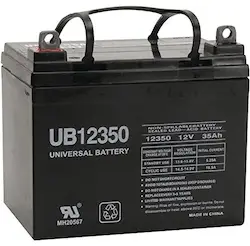
Our verdict: best SLA battery to power both kayak motor and fish finder

With 35AH the UPG 85980/D5722 battery packs enough power to run a kayak motor, which is exactly what it is most commonly used for.
In addition, many anglers also use it to power their fish finder at the same time, and this is the SLA battery that we recommend if you are planning to use both a kayak motor and a fish finder on the same fishing trip.
In spite of its power, this SLA battery is both versatile and portable, and delivers continuous and optimal service thanks to its spill-proof and valve-regulated construction.
And while it’s not a full sized deep cycle battery, when we tested it found that it does a very reliable job at powering all the electronics on a small boat or kayak, and the charge can last for several fishing trips.
Absorbent Glass Material (AGM) design helps it to resist a wide variety of shocks and physical damage without leaking, and no maintenance or re-filling is required for this sealed battery.
And during our testing we discovered that it is capable of handling all kayak electrical systems without issues on a single charge, you’ll have the ability to maintain power for the length of your kayak fishing trip.
Since this is an SLA battery, remember to charge it with an SLA battery charger. We recommend using the Peleus Tech 12V portable lead acid battery charger.
What battery to use for fish finder
Since fish finders use electricity to produce sonar pulses, they are 100% dependent on having an active battery to charge them (for more details check out our article on how does a fish finder work?).
Because of this, you need to make sure your fish finder battery doesn’t run out during your trips.
There’s nothing more annoying than a battery running low in the middle of your weekend trip, or during a fishing tournament.
While there’s definitely a wide range of different fish finder batteries available, the best one to choose is one that’s lightweight, easy to transport, and delivers sufficient battery power from start to finish of your entire fishing expedition.
If you’re thinking to use your trolling motor battery to power your fish finder, take a look at our article on do you need a separate battery for your fish finder?
Lithium vs. sealed lead acid: which battery type is best for fish finders?
Traditionally, most anglers have used sealed lead acid (SLA) batteries to power their fish finders. But recently, lithium batteries are rapidly gaining popularity as a preferred alternative.
Even though lithium batteries are more expensive, they offer significantly better performance across the board, and thus higher value for money.
On average, their charge lasts more than twice as long as that of SLA batteries, and their lifetime expectancy is 5 – 15 times longer than that of SLA batteries.
In order to avoid your battery running low, it’s best to purchase the best quality battery for fish finder that you can afford. In most cases, this will be a lithium battery, since the lifetime per charge is more than twice as long as for an SLA battery.
The main reason to choose an SLA battery instead of a lithium battery, is if you are on a tight budget, as they are more affordable than lithium batteries.
You may also want to get two batteries to run all your electrical gear, especially for night fishing, or you can keep the second battery for backup.
That way you won’t have to cut your fishing trip short if one battery runs low.
2 types of kayak fish finder battery:
There are currently 2 main battery types available for kayak fishing:
Sealed lead acid fish finder battery
Lead acid batteries (SLAs) are best known for their use as car batteries, and are traditionally the most commonly used kayak battery type.
Their main advantage is that they are inexpensive and come in a range of sizes, so you can choose the one that fits best in your kayak, while powering all your electrical needs.
On the minus side, their weight is on the heavy side, and the lifetime of a full charge is often barely enough to get you through one day of fishing. However, based on their budget friendly price, they are still a popular choice for many anglers.
Lithium fish finder battery
This battery type is best known for its use in laptop batteries, and is rapidly gaining popularity with kayak anglers.
It has three key advantages compared to SLAs: lithium batteries are significantly lighter, a full charge on a lithium battery lasts more than twice as long as a full charge on an SLA battery, and it can be recharged for 2000-7000 recharging cycles on average, while SLAs only last for 400 charging cycles on average.
In practice, this means you can use a lithium battery for several fishing trips before you have to recharge it.
On the minus side, lithium batteries are more expensive than SLAs. But for those who have extra money to spend, and want to get the best quality possible, a lithium kayak fish finder battery is definitely the best choice.
If you’re interested in getting a lithium battery, but don’t want to break the bank, check out our article: the cheapest lithium marine batteries reviewed.
Best fish finder battery for ice fishing
If you’re planning to use your battery for ice fishing, you should be aware that subzero temperatures drain a battery faster than warm weather. Because of this, our testing showed that the best battery for ice fishing is a lithium battery, since its charge lasts much longer, and we recommend the Expert Power Lithium 12V 10AH for this purpose.
This battery is perfect for an ice fishing fish finder, or for powering an ice fishing flasher, such as Vexilar or Marcum.. For more details on flashers, take a look at our review of the best flashers for ice fishing.
Best amp hour capacity for kayak batteries
Let’s go over the voltage (v) and ampere (amp) capacity that you’ll require. Refrain from buying a battery for your fish finder that has a too high voltage, since doing so could damage the fish finder.
Most fish finders use between 12 and 24 volts, and a 12 volt battery is plenty for most kayak fish finders.
Ampere capacity is given in amp hours (AH). You can calculate the amp capacity you need by checking how many amps your fish finder uses per hour.
From there, multiply your amps by the operating time desired, and use this to choose the amp hours (ah) you need in your kayak fish finder battery.
For example, if your fish finder uses 1 amp per hour, a battery with 10ah capacity should be able to run it for 10 hours.
Keep in mind that less power is drained by smaller fish finder models, while bigger models that include GPS capability may drain more. Many kayak fish finders are very compact, using less than 1 amp per hour, and so should drain the kayak battery more slowly.
During our testing we found that kayak fishing trips tend to last anywhere between 3 and 12 hours, which covers quite a wide range of amp hours. So, in order to get the best battery for your specific needs, you need to decide how long you plan to be on the water on average.
If you’ll be spending the whole day on the water, choose a battery with 10 to 16 ah capacity. If you are planning to spend just a few hours fishing at a time, a battery with a 5 to 10 ah capacity is fine. In general, it’s best to get more capacity than you expect to use, just to make sure you never run low on power.
Choose the right charger for your fish finder battery
It’s essential to charge your kayak fish finder battery correctly. Ensure that the charger you use is compatible with your battery since using an incorrect charger may damage your battery, rendering it unusable.
A lithium battery requires a different charger than an SLA battery. If you try to use an SLA charger on a Lithium battery, it won’t be able to fully charge the battery, plus you run the risk of breaking down the LiFePo4 electrolyte, which will shorten the battery’s lifespan.
So make sure you use a lithium battery charger for a LiFePO4 battery and an SLA charger for an SLA battery. Many manufacturers give specific recommendations on which charger to use for their batteries.
How to store the battery on your kayak
Since kayak fishing does tend to involve quite a lot of water splashed over the sides, it’s important to store the battery in a protected compartment that can be firmly sealed, which should ideally be watertight. That way, water will not affect the well-protected battery, enhancing both its performance and its longevity.
Final remarks
If you want to get the most out of your kayak fishing trip , it is essential to choose the right battery for your fish finder. The last thing you want is to run out of juice in the middle of your fishing day.
In order to get the perfect fish finder battery, first choose the fish finder model you want to use, and then decide how long your kayak fishing trips will last on average. Based on that information, calculate the amp hours you’ll need, and buy the right battery to cover your specfic needs.
Gear and methods used for testing
To get consistent testing results, we tested all of the fish finder batteries covered in this article based on their ability to power a Garmin Striker 7SV on an Old Town Sportsman PDL 120 fishing kayak. We chose this fish finder because it is one of the most widely used models among anglers.








